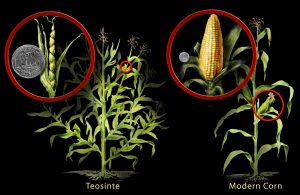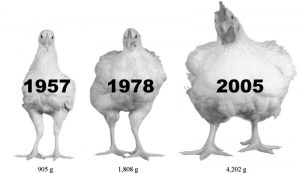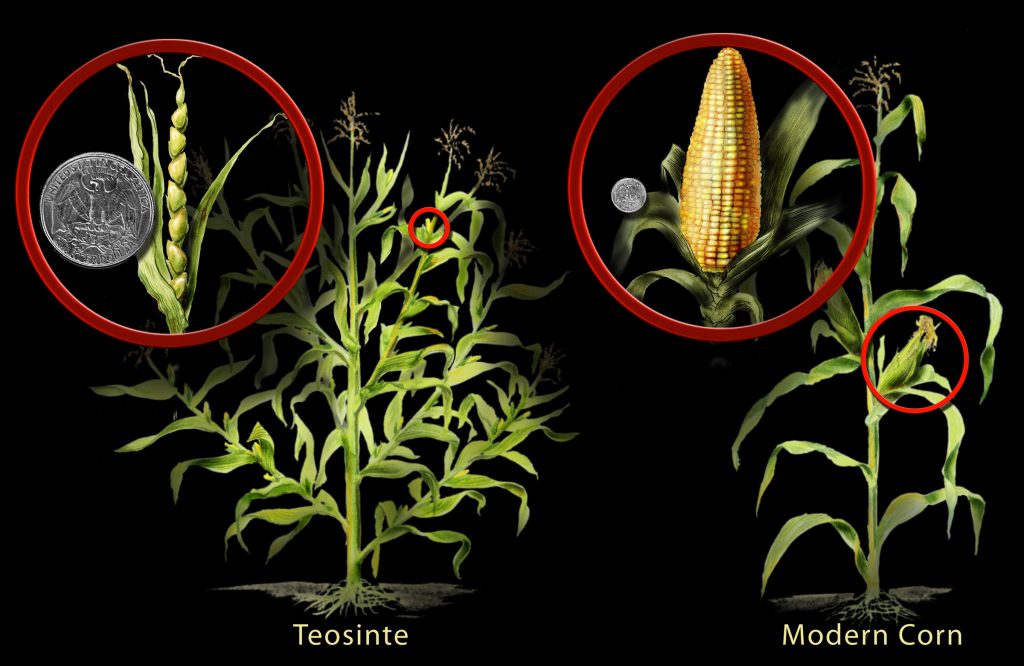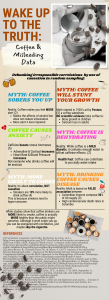
The consumption of food and water are necessary for the human body to survive. Because the population is constantly increasing, food will never be out of demand, which is why genetic modification is used to increase the size of animals to increase meat yield, such as chickens, and to increase growth rates in crops, like corn, to get products at a quicker pace. Genetic modification has also been used to make crops more resistant to pests and herbicides to make farmer’s jobs easier and reduce the loss of crops1. While genetically modified organisms (GMOs) have many benefits, how do we know when it is time to stop? And how do we know when modification no longer benefits the greater good?
Explaining GMO
Genetically modified organisms are organisms that have had their genomes purposefully modified with genetic engineering techniques to improve the organism’s traits to fit specific needs2. Genetic modification can be labeled as a variety of things: taking traits from one organism and adding them to another (recombinant DNA technique), genomic editing and removing unwanted genes, or simply selective breeding3. Humans have been using genetic modification for centuries, starting with selective breeding in plants to get foods with better traits, and eventually selective breeding in animals too. In 1866, Gregor Mendel bred different types of peas which identified the basic process of genetics and was the start of more understood genetic modification. In the 1990s, GMO products started to become readily available to the public, this includes cotton, corn, tomatoes, potatoes and more4. The benefits of genetic modification include, increased product yield, reduced pesticide and herbicide use, having longer shelf-life and increased nutritional value. While risks include, environmental harm, unintentional gene transfer, new allergens, limiting seed access, and poor treatment of animals2,3.
Genetic Modification in Plants
In today’s world, many foods seen in daily life are genetically modified, and the United States is one of the top countries to use genetic modification1.Corn, for example, is one GMO people often overlook, yet is eaten by many across the world. Originally corn was small, and the kernels were not close together. Through years of cross and selective breeding, the corn known today was evolved. More recently, corn has been modified to have Bacillus thuringiensis (Bt) genes in it that cause natural insecticide to be produced. To produce this corn, scientists have to identify what trait they want first, then the gene responsible for that trait is copied and inserted into the corn’s DNA. The scientists then grow it in a greenhouse to be monitored, then after small field testing and in-depth reviewing, it is moved to a larger field and eventually sold to farmers4.
In the 2000s, Star Link corn was a type of genetically modified (GM) corn that contained the gene for Bt toxin, Cry9C, which kills insect larvae. Because Bt toxin is heat resistant and cannot be easily broken down in human gastrointestinal tract, it was not approved for human consumption. And like many other genetically modified corn, Star Link was only approved to be used as animal feed, but it was recalled after September 2000 because it was illegally found in Taco Bell taco shells5.
Using Bt in plants like cotton, has a better outcome since people don’t consume it. In India Bt cotton has shown an increase in crop yield compared to the crops that are using chemical pest control6. Due to the increased yield, genetically modified crops have been a great resource for developing countries and countries with pest problems, since yield lost is usually due to the chemicals in pest control6. While genetically modified crops may be good for quick production, improved reliability and better quality, what are the environmental effects? While these genetically modified crops decrease herbicide use and allow for toxic waste sites to be rehabilitated, there is a risk for genes from the crops pollen or seeds to spread to non-genetically modified organisms. The insect resistance from these plants could harm insect populations and decrease the food variety for insect predators like birds. And herbicide tolerant crops can casue weeds to evolve to also be tolerant to herbicides, causing the genetically modified crop to be obsolete7.

Genetic Modification in Animals
Animals are also often genetically modified for human consumption. More commonly, animals are often fed with GMO crops, but according to the FDA, the GMO from their feed do not transfer to them and does not affect their products or meat1. While consuming GM food may not affect the animal’s meat, it can affect the animal’s life. Chickens, for example, are the most common type of meat eaten in the US. To get chickens big enough to feed a Texas sized family, broiler chickens are often seen with a mutant TBC1D1 gene, which is thought to be a link to obesity because it slows metabolism8. With this increased weight, chickens often suffer from lameness, heart failure, and sudden death. The positive side to genetically modifying chickens is their increased muscle mass causes more food for consumers. They are also more resistant to disease which will help farmers not lose chickens when one gets sick and spreads it9. Since eggs are in high demand as well, many chickens have mutations in the TSHR gene, the gene responsible for regulating fertility and breeding seasons10. Because of the mutation in this gene, hens can lay up to 300 eggs a year. This causes a deficiency in calcium and brittle bones, which leads to broken bones due to the amount they lay.
While these genetically modified organisms create more foods, they decrease the quality of food people are receiving, and could be potentially causing health problems in those who commonly consume genetically modified foods. The chickens getting genetically modified often have health problems, while testing the modifications, there are some chickens that are born in bad conditions11. And as previously stated, bone conditions can occur due to the extra weight or calcium deficiencies due to the number of eggs their body needs to produce. Although the end product gives an advantage for humans, these animals are living painful lives.

For other livestock, such as cows, they are often genetically modified to be larger or to produce more milk. Cattle genetic modification typically targets the udder and the goal is to improve the health of the udder as well as the milk quality12. The issue occurs when genomic editing is used to increase the size of cattle offspring. When a young calf is too large, the cow giving birth can have a harder time delivering it, causing it to need assistance or causing it to die12. A fetal calf can also suffer from deformations in later development stages, and although a calf is not considered a sentient being until it takes its first breath, it is still unethical to allow this deformation to happen, causing trauma to the calf as well as the cow12.
Affects in Humans
Genetic modification not only affects the environment and animals, but it also affects the humans buying and consuming genetically modified products. One issue caused by genetically modified organisms is antibiotic resistance. This happens when organisms with antibiotic resistance marker genes is consumed. While in the digestive system, gut microflora can take up modified antibiotic resistance genes and reduce the effectiveness of antibiotics in humans which can increase the risk of antibiotic-resistant diseases13. Although most scientific studies have disproven this, it is still a concern many consumers have due to the health crisis that would follow.
Although studies have disproven antibiotic resistance, one thing has been a common reoccurrence with consumption or use of genetically modified organisms, and that is the increase of people with allergies13. In the past 10 years, both the United States and United Kingdom have experienced an increase of people with a soya allergy and have had an epidemic of Morgellons disease, which causes a person to have a sensation as if something were crawling beneath their skin13,14. The evidence possibly connecting Morgellons to genetic modification is the Agrobacterium DNA found in biopsies from patients with this disease14. Agrobacterium tumefaciens is a soil dwelling pathogen that causes tumor like growths on plants it infects. It is often used as a method for plant genetic modification because it can reliably transfer large DNA fragments into plants. By the late 1990s, Agrobacterium vector was widely used and it wasn’t until a few years later that a research group in Israel discovered it is widely infectious to natural vegetation, and later more research showed it could infect animal and human cells14. In 2012, the CDC claimed Morgellons disease had no connection with Agrobacterium and it is just a delusional infestation, but some researchers believe it could also be caused by genetically modified cotton that contain Bacillus thuringiensis, which causes the plant to produce insecticide proteins14.
Conclusion
Although genetic modification has had many great advantages, such as helping poorer countries and lessening the use of harmful chemicals on crops, most negative effects are seen in animals like mice, cows, and other livestock. The enviornment is affected some, but it is mainly helped by genetic modification rather than hurt. There are some cases where genetically modified foods have affected humans, but most get disproven or there isn’t a significant enough connection to say it was caused by genetically modified organisms. Because of that, more long-term research should be done on genetically modified organisms especially on crops grown and foods people consume. If more long-term research is applied then genetic modification can be more trustworthy for the average person.
References
1. Center for Food Safety and Applied Nutrition. (2022, August 3). GMO Crops, Animal Food, and Beyond. U.S. Food And Drug Administration.
2. Uzogara, S. G. (2000, June 21). The impact of genetic modification of human foods in the 21st Century: A Review. Biotechnology Advances.
3. Center for Food Safety and Applied Nutrition. (2022a, February 17). Types of Genetic Modification Methods for Crops.
4. Center for Food Safety and Applied Nutrition. (2022, August). Science and history of gmos and other food modification processes.
5. Schmitz, T. G., Schmitz, A., & Moss, C. B. (2005). The economic impact of StarLink corn. Agribusiness, 21(3), 391.
6. Qaim, M., & Zilberman, D. (n.d.). Yield effects of genetically modified crops in developing countries.
7. Genetically modified crops and the environment | agronomy journal – ACSESS. (2000, July).
8. Gu, X., Feng, C., Li, M., Song, C., Wang, Y., Yang, D., . . . Li, N. (2011). Genome-wide association study of body weight in chicken F2 resource population. PLoS One, 6(7)
9. Eenennaam, A. L. V. (2016, November 16). Genetic modification of Food Animals. Current Opinion in Biotechnology.
10. Ramey, H. R., Decker, J. E., McKay, S. D., Rolf, M. M., Schnabel, R. D., & Taylor, J. F. (2013). Detection of selective sweeps in cattle using genome-wide SNP data. BMC Genomics, 14
11. Dennis, M. (2002, April 01). Welfare issues of genetically modified animals.
12. Eriksson, S., Jonas, E., Rydhmer, L., & Röcklinsberg, H. (2017, November 06). Invited review: Breeding and ethical perspectives on genetically modified and genome edited cattle.
13. Maghari, B. M., & Ardekani, A. M. (2011). Genetically modified foods and social concerns. Avicenna journal of medical biotechnology, 3(3), 109–117.
14. Ho, M. (2013). The new genetics and natural versus artificial genetic modification. Entropy, 15(11), 4748-4781.
15. Edmisten, K. (2015). What is the difference between genetically modified organisms and genetically engineered organisms? NC State Extension News. Retrieved October 27, 2022, from https://agbiotech.ces.ncsu.edu/q1-what-is-the-difference-between-genetically-modified-organisms-and-genetically-engineered-organisms-we-seem-to-use-the-terms-interchangeably/
16. Locke, S. (2014, October 2). Chickens have gotten ridiculously large since the 1950s. Vox. Retrieved October 27, 2022, from https://www.vox.com/xpress/2014/10/2/6875031/chickens-breeding-farming-boilers-giant



26 comments
aramirez104
Amazing article, very well-deserved award! I have always read up on GMO processed foods and have had my opinions against the consumption of GMO foods, but when you go to general supermarkets like Walmart or H-E-B, there are GMOs in about half of the products there! Most articles I have read have stated there are more pros than cons regarding these types of modifications for reasons you listed such as increased yield, enhanced nutritional contents, resistance to pests/diseases, and addressing nutritional deficiencies in foods. But you touched on the cons efficiently and effectively! Balancing the innovation and ethical considerations developments like this is so important.
I was fascinated by the mutant TBC1D1 gene found in chickens and its linkage with slowing down metabolism and the TSHR mutation for chicken breeding! I am interested in seeing health research done in the future on consumers of GMOs and the overall environmental and socioeconomic effects.
Xavier Bohorquez
Congrats on the Award! The simple topic dealing with genetic modifications in our food, and diet, was something I never thought I could get hooked on until I read this topic. This article was something varying from newer information to wonderful visuals, and this was something that I could be engaged with 100%. The light summary of food development and the issues with modifications is the type of awareness we need/.
Marissa Rendon
Congratulations on your award! This was an excellent educational article I read. I liked that dates were being used in this article to to confirm the progressions of GMO’S, I found this to be very informative. This was an excellent example that clearly explains what GMO is. I strongly believe our food is not 100% natural and organic and this article definitely helped me see things clearly
Ana Diaz
Congratulations on your award! This was a fascinating article to read. I love food and cooking, but I often feel like the way we grow our food is unethical, especially in the US. I think it is sad that in order to make more money, food companies rely on destroying the livelihood of livestock. It is astonishing to see how large chickens have been made to be through genetic modification. The thing I am thinking most about now is if all this is really worth it since food waste in the US is so high. Do we really need to keep genetically modifying and producing this much food and if not what is the alternative?
Geraldine Fry
Hi Aryana Garcia,
I really enjoyed reading your article about Genetic Modification. I appreciated that you listed the cons and benefits of EMOs. It’s scary to think we do not know how GMOs affect humans yet since we still need long-term testing. I wish there was an option for consumers without GMOs other than expensive organic food that most of the time still has GMOs. Thank you for shining a light on this important topic.
Hunter Stiles
Hi Aryana! I would like to first offer a congratulations on the success of your article. I really liked the organization level that you used when writing this. I liked how you used dates to confirm the progression of GMOs because it reminds us that we haven’t been working with them for all that long. I liked how your provided example for GMO usage was corn, I feel like using that example allows the public to be more inclined to focus in on your article because it is something that a majority of our population consumes as a whole. I also that like with the example being used, corn, you also provided a picture that shows what corn was derived from and then how it was genetically modified to look like vegetable that we all know and love today. I feel as though a lot of people can develop a better understanding of GMO usage and development after reading this article.
I enjoyed this read, thank you.
Isabella De Paolo
Congratulations on your nomination! The article was very interesting to read and organized in a way that allowed it to flow nicely. The information in your article was very relevant to the reader, as most of us consume modified foods. I never knew that corn had been so genetically modified that it now grows with insecticide genes. It really makes me wonder how much we actually know about the food we ingest.
Alyssa Leos
First I want to say congratulations on your article being nominated for an award! I really like how you divided each section of your article so we know what we are reading about. Learning about genetic modification was probably always my favorite topic to learn about. Your article was really well written and had a lot of information about stuff I didn’t even know. Again congratulations on your article nomination! Well deserved.
Guadalupe Altamira
Congratulations on your nomination! This was a very informative and alarming article since it revolves around what we eat as humans. This article really shows the truth behind GMOs on many things we eat like plants and animals. Science and technology evolved so that they went into the animals we eat and the plants were harvested. Overall great article and I enjoyed reading this article.
Dejah Garcia
Congratulations on your article! What a very interesting article. Im glad you brought up this topic it was very informatice and helped me get a better understanding of what specifically could be going into our bodies. I love your diction and imagery you used in the article. Again congratulations best of Luck 🙂